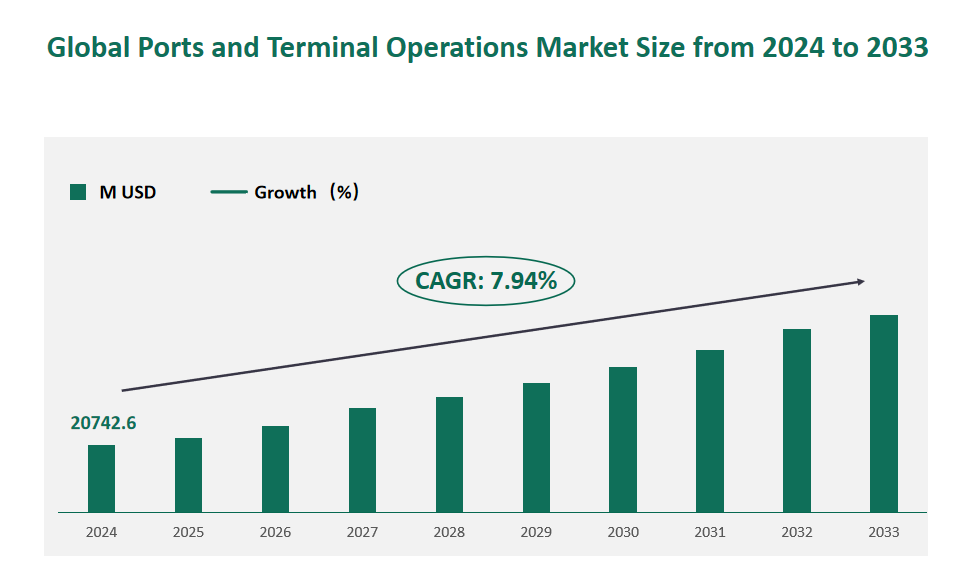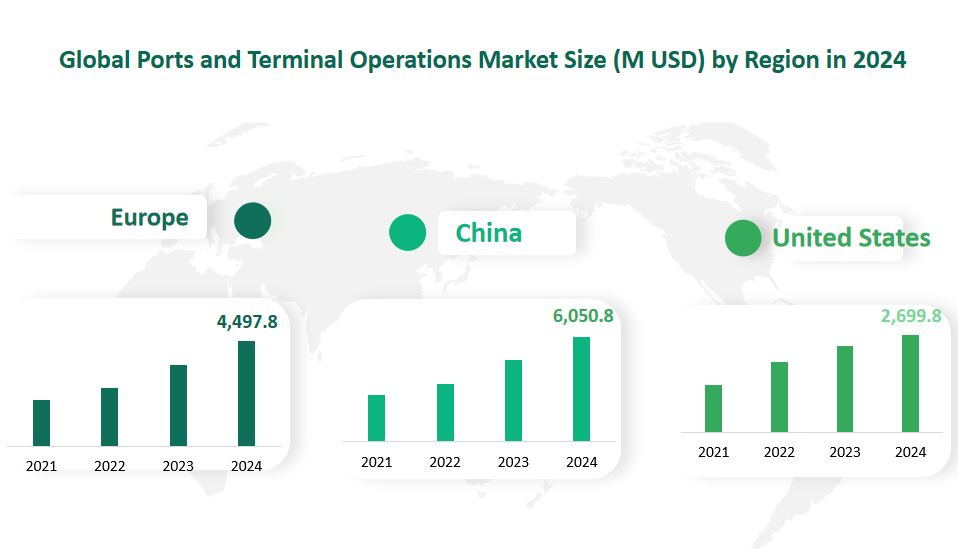1 Global Ports and Terminal Operations Market Size (Value) and CAGR (2024-2033)
In 2024, the global Ports and Terminal Operations market was valued at USD 20742.6 million, with a CAGR of 7.94% from 2024 to 2033.
Ports and Terminal Operations refers to the services provided at ports and terminal, which include cargo handling, storage, transshipment, and cargo delivery to vessels, as well as related services.
Figure Global Ports and Terminal Operations Market Size (M USD) and CAGR 2024-2033

2 Ports and Terminal Operations Market Drivers
Economic Globalization and Trade Expansion
One of the primary drivers of the Ports and Terminal Operations market is the increasing trend of economic globalization. As countries continue to engage in international trade, the demand for efficient and reliable port operations has surged. The rapid growth of global trade volumes, particularly in emerging economies, has led to a significant increase in the movement of goods across borders. This has necessitated the expansion and modernization of port facilities to handle larger volumes of cargo. For instance, the rise in containerized shipping has been a major catalyst for the development of port infrastructure, as ports need to accommodate larger vessels and more frequent shipments.
E-commerce Boom
The rapid growth of e-commerce has also had a profound impact on the Ports and Terminal Operations market. With more consumers purchasing goods online, there has been a corresponding increase in the demand for logistics and transportation services. E-commerce platforms require efficient supply chains to deliver products quickly and reliably, which in turn drives the need for robust port operations. The expansion of e-commerce has led to an increase in the volume of small packages and high-value goods being shipped, necessitating advanced handling and storage facilities at ports.
Technological Advancements
Technological innovations are playing a crucial role in enhancing the efficiency and productivity of port operations. The adoption of smart port technologies, such as automation, artificial intelligence, and the Internet of Things (IoT), is transforming traditional ports into smart ports. These technologies enable real-time monitoring of infrastructure, predictive maintenance, and optimized operational activities. For example, automated cranes and container handling systems can significantly reduce turnaround times for vessels, improving overall port efficiency.
3 Ports and Terminal Operations Market Restraints
High Industry Barriers to Entry
The Ports and Terminal Operations industry is characterized by high barriers to entry, making it difficult for new players to establish a foothold. These barriers include stringent safety and security requirements, the need for specialized equipment and infrastructure, and the necessity for robust logistics networks. Ports and terminals are critical to national economies and require significant investment in terms of capital, technology, and human resources. The regulatory environment is also complex, with strict environmental and operational standards that must be met. These factors collectively create a challenging landscape for new entrants, limiting competition and potentially stifling innovation.
Capital-Intensive Nature of the Industry
The development and operation of ports and terminals require substantial capital investment. The construction of modern port facilities, including berths, cranes, and storage areas, involves significant upfront costs. Additionally, the maintenance and upgrading of existing infrastructure require continuous financial commitment. The long payback periods associated with these investments can deter potential investors and limit the financial flexibility of existing operators. The high capital intensity of the industry also means that operators must carefully manage their financial resources to ensure sustainability and profitability.
Environmental and Regulatory Constraints
Ports and terminal operations are subject to a range of environmental regulations aimed at minimizing their impact on the environment. These regulations include emissions standards for ships, waste management protocols, and measures to protect marine ecosystems. Compliance with these regulations can be costly and complex, requiring significant investment in green technologies and sustainable practices.
4 Global Ports and Terminal Operations Market Size and Share by Type in 2024
Stevedoring is the most prominent type within the Ports and Terminal Operations market. It involves the loading and unloading of cargo from ships, typically at seaports, major container terminals, or inland transportation hubs. Stevedores use specialized equipment such as cranes to move containers on and off vessels. In 2024, the stevedoring segment is projected to have a market value of 15,733.5 million U.S. dollars. This segment is characterized by its critical role in ensuring the efficient movement of goods, which is essential for maintaining the flow of international trade.
Cargo handling and transportation refer to the movement of goods from one place to another, including loading them into ships, aircraft, or other vehicles. This segment also encompasses the transportation of cargo via rail, road, and water systems. In 2024, the market value for cargo handling and transportation is estimated at 3,429.4 million U.S. dollars. This type is vital for connecting different parts of the global supply chain, ensuring that goods reach their intended destinations efficiently and on time.
Table Global Ports and Terminal Operations Market Size and Share by Type in 2024
Type | Market Size (M USD) 2024 | Market Share 2024 |
Stevedoring | 15733.5 | 75.85% |
Cargo Handling and Transportation | 3429.4 | 16.53% |
Others | 1579.7 | 7.62% |
5 Global Ports and Terminal Operations Market Size and Share by Application in 2024
Food transportation involves the movement of perishable and non-perishable food products from production sites to distribution centers and ultimately to consumers. This segment requires specialized handling and storage facilities to ensure the integrity and safety of food products. In 2024, the market value for food transportation is projected to be 9,064.4 million U.S. dollars. This segment is driven by the increasing demand for global food trade and the need for efficient logistics to reduce spoilage and waste.
Coal transportation involves the movement of coal from mines to power plants or export terminals. This segment requires robust infrastructure to handle large volumes of bulk cargo. In 2024, the market value for coal transportation is projected to be 2,903.6 million U.S. dollars. The demand for coal transportation is influenced by global energy needs and the shift towards cleaner energy sources, which may impact the long-term growth of this segment.
Steel transportation involves the movement of steel products from production facilities to end-users. This segment requires specialized equipment to handle heavy and bulky steel products. In 2024, the market value for steel transportation is projected to be 5,256.3 million U.S. dollars. The demand for steel transportation is closely tied to the construction and manufacturing industries, which are key drivers of economic growth.
Table Global Ports and Terminal Operations Market Size and Share by Application in 2024
Application | Market Size (M USD) 2024 | Market Share 2024 |
Food Transportation | 9064.4 | 43.70% |
Coal Transportation | 2903.6 | 14.00% |
Steel Transportation | 5256.3 | 25.34% |
Others | 3518.4 | 16.96% |
6 Global Ports and Terminal Operations Market Size by Region in 2024
United States is a significant region for Ports and Terminal Operations. The region is characterized by advanced port infrastructure and a strong focus on efficiency and sustainability. In 2024, the market value for United States is projected to be 2,699.8 million U.S. dollars. The region benefits from robust trade relationships with other parts of the world, particularly Asia and Europe.
Europe is another key region for Ports and Terminal Operations, with major ports in countries such as Germany, the UK, France, and Italy. The region is known for its advanced logistics and transportation networks. In 2024, the market value for Europe is projected to be 4,497.8 million U.S. dollars. European ports play a crucial role in facilitating trade within the region and with other continents, particularly Asia and North America.
China is the largest and fastest-growing segment in the global Ports and Terminal Operations market. In 2024, the market value for the China is projected to be 6,050.8 million U.S. dollars. The region’s growth is driven by increasing trade volumes, the development of new port infrastructure, and the expansion of e-commerce.
Figure Global Ports and Terminal Operations Market Size by Region in 2024

7 Major Players in Global Ports and Terminal Operations Market
7.1 PSA International
Company Profile:
PSA International is a leading global port operator headquartered in Singapore. Established in 1964, PSA has grown to become one of the world’s most efficient and technologically advanced port operators. The company operates in over 40 locations across Asia, Europe, the Americas, and Africa, handling a diverse range of cargo, including containers, bulk, and breakbulk.
Business Overview:
PSA International provides comprehensive port management, cargo handling, harbor pilotage, and port-related logistics services. The company is renowned for its state-of-the-art facilities and innovative solutions, which enhance operational efficiency and sustainability. PSA’s commitment to digital transformation and smart port technologies has positioned it as a leader in the industry.
Product Profiles:
PSA International’s operations include stevedoring, cargo handling, and transportation services. The company’s latest facilities at Pasir Panjang Terminals (PPT) 4, 5, and 6 are equipped to handle the world’s largest container vessels, featuring 18-meter deep water draft and fully automated electric yard crane systems.
Recent Financial Performance:
In 2022, PSA International reported a revenue of 1,545.0 million U.S. dollars, with a gross profit of 516.8 million U.S. dollars.
7.2 APM Terminals
Company Profile:
APM Terminals is a global terminal operator with a presence in 75 key locations worldwide. Established in 2001 and headquartered in the Netherlands, APM Terminals is part of the A.P. Moller – Maersk Group. The company is known for its commitment to sustainability and innovation, offering a wide range of terminal services and logistics solutions.
Business Overview:
APM Terminals provides comprehensive terminal management and logistics services, including container handling, storage, and transportation. The company’s operations are characterized by advanced technology and a focus on reducing environmental impact. APM Terminals’ commitment to sustainability has led to the adoption of various green initiatives, enhancing its global reputation.
Product Profiles:
APM Terminals’ services include fully automated container handling, barge crane operations, and logistics solutions. The company’s terminals are equipped with advanced technology to ensure efficient and reliable cargo handling, making it a preferred choice for shipping lines and logistics companies.
Recent Financial Performance:
In 2022, APM Terminals reported a revenue of 1,265.1 million U.S. dollars, with a gross profit of 419.9 million U.S. dollars.
7.3 DP World
Company Profile:
DP World is a leading global marine and inland terminal operator headquartered in the UAE. Established in 1972, DP World operates in over 80 countries and is known for its innovative solutions and commitment to sustainability. The company’s diverse portfolio includes ports, terminals, logistics parks, and economic zones.
Business Overview:
DP World engages in the development and management of international marine and inland terminal operations, maritime services, industrial parks, and logistics solutions. The company’s operations are characterized by advanced technology and a focus on efficiency and sustainability. DP World’s commitment to innovation has led to the adoption of smart port technologies, enhancing its global reputation.
Product Profiles:
DP World’s services include port and terminal operations, crane services, container services, and general cargo handling. The company’s terminals are equipped with advanced technology to ensure efficient and reliable cargo handling, making it a preferred choice for shipping lines and logistics companies.
Recent Financial Performance:
In 2022, DP World reported a revenue of 1,117.0 million U.S. dollars, with a gross profit of 374.3 million U.S. dollars.

